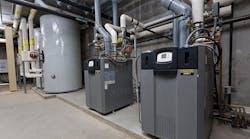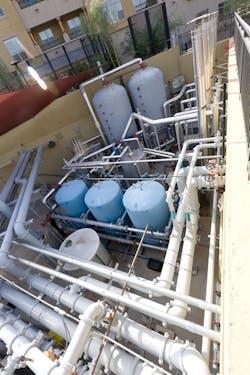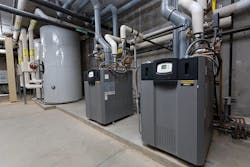Located in north Phoenix, Sagewood is a retirement community offering a resort-like, natural desert setting and amenities and services focused on independence and well-being to approximately 275 seniors. In addition to a variety of residence types—from stand-alone casitas and villas to lofts and apartment homes—the Life Care Services community provides a host of resources, including 38-bed Acacia Health Center at Sagewood, on its 80-acre campus.
Design of Sagewood’s domestic-hot-water plant presented two challenges, Victor Rilling, owner of Mechanical Room Inc., a Phoenix-based hydronics sales and solutions provider, said: “It needed to deliver a continuous supply of domestic hot water for the health center, and it needed to supply the variable domestic-hot-water needs for the condos and the laundry. The solution had to handle two different duties as reliably and efficiently as possible.”
Ultrahigh-Efficiency Solution
The specifications, written by Phoenix-based LSW Engineers Arizona Inc., called for a high-efficiency boiler plant supplying several water-storage tanks with domestic hot water.
“The installation was designed to produce thousands of gallons of hot water every day,” Anthony Abbruzzio, vice president of field operations for Glendale, Ariz.-based RKS Plumbing & Mechanical Inc., said. “But there were two sides to the project: an outdoor mechanical yard that contained the boilers and storage tank for the Sagewood senior-living complex and an indoor mechanical room containing the boilers and storage tanks for the Acacia Health Center.”
Brandon Studer, service operations manager for RKS, and his team, which designed the mechanical yard and installed the equipment, piping, and wiring, worked closely with Mechanical Room Inc., which provided the equipment and made sure the piping and check valves met the specifications.
“To generate the required capacity for Sagewood, we went with five Laars Rheos boilers, each with 2,400-MBH capacity,” Rilling said. “Four were used for the residential towers, one for the laundry.
“We used the highest-capacity non-condensing Rheos commercial boiler water heaters that Laars makes,” Rilling continued. “Although the Sagewood specs called for non-condensing boilers, energy efficiency was still important. The Rheos we used is rated for 86.9 percent thermal efficiency, among the highest in its class. But by employing advanced boiler and heat-timer controls, we could take advantage of the modulating burner to down-fire the boiler as low as 50 percent of full input. That helps cut operating costs as much as 30 percent compared to conventional, non-modulating systems.”
At the time of the boilers’ installation, natural gas in Arizona was commercially priced at $2.50 per therm. With the boilers’ high thermal efficiency, that meant, for example, a $200,000 annual gas bill could be cut down to $140,000, saving $60,000 a year compared with less-efficient non-modulating designs.
“We also liked the fact that the systems have one of the highest heat densities and smallest footprints available,” Abbruzzio said. “The unit is just under 34.5 in. wide, and it can be installed indoors or outdoors. We didn’t have a lot of square footage in the outdoor yard, so the boiler’s width meant we could minimize construction costs by reducing the size of the yard by fitting five units in a row alongside the storage tank and water softener.”
Boosting Capacity
Four of the five boilers supplied two 4,610-gal. water-storage tanks from Niles Steel Tank Co. (NST) with sprayed-on rigid insulation and 100-percent acrylic topcoat to withstand outdoor exposure in the mechanical yard. The other fed a 675-gal. tank from NST that was jacketed and insulated for the outdoor application.
“As a custom manufacturer, Niles builds ASME pressure vessels and process tanks in a wide range of sizes,” Rilling said. “In this case, we took advantage of their custom capability and vertical configuration to fit a lot of capacity in a tight space. These tanks also employ a glass lining that was applied to the interior steel surface to withstand the corrosive effects of high-temperature hot water.”
Another factor was the effect of hard water. On average, about 95 percent of Phoenix’s water comes from lakes and rivers. Hardness levels can reach 20 grains per gallon (gpg), well over the 7-gpg limit used by the U.S. Department of the Interior to define hard water. Consequently, the specs called for a 2.4-million-grain-capacity softener. To meet the spec, Rilling supplied a Triplex Water Softener Skid from Marlo Inc. rated for 2,000 gpm, which came complete with a programmable logic controller to provide parallel progressive flow to meet the required capacity level.
With the large water-storage tanks located away from points of use, a SmartPlus circulator from Taco Inc. was installed. SmartPlus monitors and records hot-water usage for seven days. For the next seven days, it repeats the preceding week’s usage pattern to cycle the pump, providing instant hot water at all fixtures only when needed. No timers or aquastats are required.
Non-stop Hot Water
For the indoor mechanical room, two Laars NeoTherm condensing boilers were supplied.
“The health center uses hot water non-stop,” Rilling noted, “so it was a no-brainer that we needed to go with an ultraefficient modulating-boiler design.”
The two NeoTherms each provide 399-MBH capacity, firing in a lead-lag sequence. Also, they employ a modulating burner that enables 96.5-percent thermal efficiency. In this case, the modulating burner can achieve a 5-to-1 turndown ratio, which allows lower-temperature return water to be used to achieve higher efficiency.
The hot water generated by the NeoTherms is piped to two 1,000-gal. glass-lined NST water-storage tanks. The tanks are jacketed and insulated for standby heat loss to less than 0.5°F per hour.
“The health center is using hot water continuously for washing, bathing, cleaning,” Rilling said. “So, two tanks provide the redundancy and capacity to make sure hot water is always available. The setup also minimizes boiler standby losses and energy-wasting on-off cycling. We want a long firing cycle to make sure every possible Btu goes into producing hot water, rather than wasted in frequent boiler startups.”
Jim White, director of operations for Sagewood, is very pleased with the operation of the equipment.
“We’re getting very dependable, problem-free performance,” White said. “The central-plant concept has worked well.”
Studer added: “The NOx and CO greenhouse-gas output is extremely low with these boilers. That’s exactly the kind of environmentally friendly performance that our customers in the southwest, like Sagewood, really appreciate.”
John Vastyan is president of Common Ground, a trade-communications firm based in Manheim, Pa.











